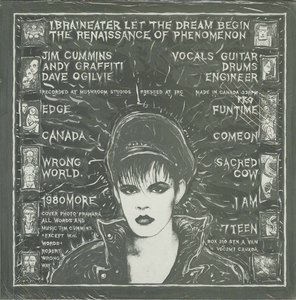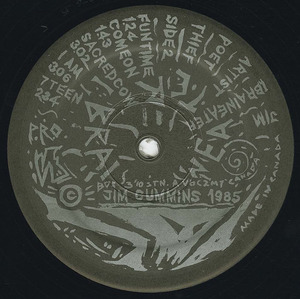Information/Write-up
I, Braineater began as one of Vancouver’s most unusual contributions to the first wave of Canadian punk, but the project was never only about music. It was the living, evolving persona of artist Jim Cummins—painter, illustrator, provocateur—whose work fused underground comics, glam theatricality, punk provocation, and a deeply West Coast surrealism. Emerging from the Langley/Surrey/White Rock scene that also produced the Shmorgs and the Monitors, Cummins spent the mid-1970s orbiting the same circles as a young Art Bergmann, designing gig flyers for the Mount Lehman Grease Band and absorbing the aesthetics of outsider art, glam, and the quickly shifting counterculture. When the first punk singles from New York and London began reaching the suburbs in 1977–78, Cummins devoured them obsessively with friends like Bergmann and John Armstrong, sensing in this new movement a space where raw expression and visual disturbance could coexist.
By the time he relocated to Vancouver proper, Cummins was already more of an art-world presence than a musician. He haunted the Quadra and the Windmill, photographing bands and finding himself pulled deeper into a downtown community where painters, performance artists, drag performers, and punks intermingled long before such cross-pollination became fashionable. Recognized immediately by members of the older art establishment—figures such as Allan Wood and Bill Featherstone—Cummins understood instinctively how to turn himself into a brand, a character, and a narrative. The persona “I, Braineater” was born from this collision: half comic-book grotesque, half glam cabaret phantom, and half punk antagonist. The third half was intentional.
The first musical incarnation appeared in 1979 under the name Braineater (often referred to retrospectively as The Braineaters), an all-star Vancouver ensemble that Cummins assembled for performances and recordings. This debut lineup included scene heavyweights Buck Cherry of the Modernettes and Art Bergmann of the K-Tels/Young Canadians, musicians whose involvement instantly tied the project to Vancouver’s explosive punk moment. Their debut EP—issued as a seven-inch and packaged in a colour silkscreened manila envelope—was as much an art object as a record, a sharp jolt of punk minimalism wrapped in Cummins’ signature visual style. The sleeve read “I, Braineater,” though the group was known as Braineaters at the time, setting the stage for the persona to eventually eclipse the band entirely.
After this brief but influential first configuration, Cummins shifted direction and recruited bassist-singer Trevor Jones-Arntzen and conga player Ivo Zenatta, both deeply connected to Vancouver’s gallery and art-school milieu. Their trio was deliberately unconventional—no drum kit, no attempt to mimic the standard punk setup—and the result polarized audiences. What emerged, however, was a sound that defied existing categories. Critics strained to describe it; journalist Alex Varty came closest when he dubbed them “Baroque Rockabilly Futurists,” a phrase that captured the odd mix of tension, theatricality, and experimental edge that defined their performances. Jones-Arntzen would later launch a solo career, but his earliest public identity remained inseparable from this period of radical experimentation.
The project continued evolving. Cummins’ next major collaborator was multi-instrumentalist Steve Laviolette (later remembered widely after his passing), with whom he formed a highly elastic two-man version of I, Braineater that operated more like an art troupe than a conventional band. By 1984, yet another incarnation emerged with drummer Andy Graffiti, at a moment when Cummins’ expanding visual art practice was gaining momentum. Throughout these years he served as an unlikely but essential bridge between the punk scene and the more fluid, queer-inclusive discotheque and performance-art circles of Vancouver. Les sez, a contemporary observer, noted that Cummins was “the conduit from the punk scene to the punk-friendly gay and discotheque venues,” a role that broadened the audience for early punk in the city and shaped the hybrid identity of I, Braineater. He was equally comfortable in the art gallery, the dive bar, and the late-night drag set—a rare fluidity in the Vancouver of the early ’80s.
The recordings from these shifting ensembles capture the rapid evolution of the project. The 1979 Braineaters EP remains a cornerstone of the early Vancouver punk canon, a raw and unfiltered blast featuring Buck Cherry and Art Bergmann alongside Cummins, Laviolette, and Trevor Jones. Its 1996 reissue only strengthened its cult status. The following year’s Planet X—issued in 1980 as a flexi-disc for Eva-Tone Soundsheets in the United States—pushed further into art-punk surrealism. Its jagged rhythms, sci-fi atmospheres, and unhinged vocal performances positioned Braineaters as one of the few Canadian groups exploring the boundary between punk, performance art, and cartoon futurism. Original copies were notorious for their unusual packaging: triangular or square sleeves, custom hand-painted art, and large-format posters that transformed the release into a limited-edition gallery piece. Many editions included a 17½" × 23" painting and a suite of custom posters—each unique, each unmistakably Cummins.
As the 1980s progressed, the name I, Braineater became less the title of a band and more the umbrella for Cummins’ entire artistic output. He continued releasing recordings through the decade, including the albums I, Here — Where You! and Artist Poet Thief, each reflecting his ongoing exploration of identity, abstraction, and the grotesque. He contributed tracks to compilations, soundtracks, and multi-artist projects, including the cult film Terminal City Ricochet. But the broader impact of I, Braineater lay in the totality of Cummins’ vision—a multidisciplinary approach in which music, painting, illustration, printmaking, and persona merged inseparably.
By never relocating to New York or London despite encouragement from peers, Cummins remained a resolutely Vancouver figure—a downtown institution whose influence quietly radiated through generations of local artists. His posters, album covers, and paintings became fixtures of the city’s underground visual landscape, bridging punk energy with a glam-inflected comic-horror sensibility. The persona he created helped define the aesthetic of Vancouver’s emerging alternative culture, where punk collided with drag, art school experimentation, and the performance art scene.
Today, I, Braineater stands not simply as a band or a musical footnote, but as one of the most distinctive multimedia projects in Canadian underground history. Jim Cummins’ work blurred the borders between disciplines long before such hybridity became commonplace. His legacy endures not only in rare, sought-after recordings like the Braineaters EP and Planet X, but in the influence he exerted on Vancouver’s cultural identity—fiercely original, visually confrontational, sonically unpredictable, and forever committed to the idea that art should be lived, embodied, and uncontainable.
-Robert Williston
Jim Cummins: guitar, vocals
Andy Graffiti: drums
Engineered by Dave Ogilvie
Recorded at Mushroom Studios, Vancouver, British Columbia





Great Album I've had a mix cassette of unknown origin with this compilation on it for over 30 years. I never knew what the band was until recent AI research finally gave me a breakthrough! Was an exciting moment and nice to find a cleaner sound version on this website as my cassette was worn out. You can say I'm an old fan who thought I would never find out who you were.. so also your newest fan